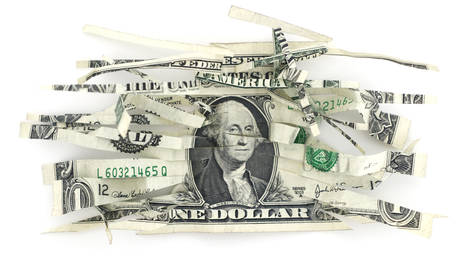
The Fed has now shed 29% of Treasuries it had added during pandemic QE starting in March 2020.
By Wolf Richter for WOLF STREET.
The Fed’s Quantitative Tightening (QT) continues on track, and the unwinding of the March bank-panic measures took a leap forward as the FDIC paid off the rest of its loans from the Fed.
Total assets on the Fed’s balance sheet dropped by $129 billion in November, to $7.74 trillion, the lowest since April 2021, according to the Fed’s weekly balance sheet today. Since peak-QE in April 2022, the Fed has shed $1.228 trillion of its total assets. The closeup view:
From crisis to crisis to raging inflation:
During QT #1 between November 2017 and August 2019, the Fed’s total assets dropped by $688 billion, but inflation was below or at the Fed’s target (1.8% core PCE in August 2019). At the time, the Fed was just trying to “normalize” its balance sheet.
Now inflation is still doing a lot of heavy breathing in services, though energy prices have plunged and durable goods prices have ticked down. Within the Fed’s favored PCE price index, core services inflation is still burning at a rate of 4.6%. Within CPI, core services inflation is still burning at 5.5%.
QT marches on.
Treasury securities: -$60 billion in November, -$959 billion from peak in June 2022, to $4.81 trillion, the lowest since February 2021.
The Fed has shed 29.3% of the $3.27 trillion in Treasury securities that it had added since March 2020 as part of its pandemic QE.
Treasury notes (2- to 10-year securities) and bonds (20- & 30-year securities) “roll off” the balance sheet mid-month or at the end of the month when they mature and the Fed gets paid face value for them. The roll-off is capped at $60 billion per month, and about that much has been rolling off, minus the inflation protection the Fed earns on Treasury Inflation Protected Securities (TIPS) which is added to the principal of the TIPS.
What Treasury bills do for QT. These short-term securities (1 month to 1 year) are included in the $4.81 trillion of Treasury securities on the Fed’s balance sheet. But they play a different role.
The Fed lets them roll off (mature without replacement) to fill in the gap when not enough longer-term Treasury securities mature and roll off to get to the $60-billion monthly cap. As long as the Fed has T-bills, the roll-off of Treasury securities will reach the cap of $60 billion every month.
But when the Fed runs out of T-bills to fill in any gap, the Treasury roll-off will fall below the $60 billion cap. So we keep an eye on these T-bills because as long as there is still a stash of T-bills, the Treasury roll-off can proceed at a constant pace of $60 billion a month.
From March 2020 through the ramp-up of QT, the Fed held $326 billion in T-bills that it constantly replaced as they matured by buying new T-bills at auctions (the flat line in the chart). In September 2022, T-bills first started rolling off as needed to get the Treasury roll offs to $60 billion a month.
T-bills are now down to $230 billion. No T-bills rolled off in November. Less than $1 billion rolled off in December (this week). In total, $96 billion in T-bills have rolled off.
The Fed’s shrinking weight in the bond market: The US national debt has ballooned to $33.8 trillion. This debt comes in two categories:
One: $26.8 trillion of Treasury securities are “held by the public”; they are traded and are held by investors of all kinds, including by the Fed. They’re the Treasury bond market.
Two: $7.0 trillion of Treasury securities are held by entities of the US government (“held internally”), such as by US government pension funds and the Social Security Trust Fund, and they’re not part of the bond market.
The Fed’s share of Treasury securities that are in the bond market has fallen to 17.9%, down from over 24% at the peak.
The Fed’s weight in the bond market, though still massive, has diminished due to two factors: QT reduced the Treasury securities on the Fed’s balance sheet; while the government deficit is ballooning the marketable securities (the data points in the chart are quarterly, except the current data point which reflects today’s data).
Mortgage-Backed Securities (MBS): -$16 billion in November, -$293 billion from the peak, to $2.45 trillion, the lowest since September 2021.
The Fed only holds government-backed MBS, and taxpayers carry the credit risk. MBS come off the balance sheet primarily via pass-through principal payments that holders receive when mortgages are paid off (mortgaged homes are sold, mortgages are refinanced) and when mortgage payments are made.
The higher mortgage rates have caused home sales to plunge and refis to collapse, which slowed the mortgage payoffs, and therefore the pass-through principal payments. The MBS run-off has been between $15 billion and $21 billion a month, far below the $35-billion cap.
Bank-panic measures unwind.
Repos: $0. Repos on the Fed’s balance sheet come in two flavors:
Repos with “foreign official” counterparties were paid off in April. At the peak in March 2023, they reached $60 billion, likely with the Swiss National Bank which was backstopping the take-under of Credit Suisse by UBS (the little jag in the chart below).
The repos with US counterparties faded out in July 2020, when the Fed made the terms less attractive. The Fed currently charges 5.5% on repos, as part of its policy rates, and there were no takers.
Loans to FDIC: -$47 billion in November to $0 as the FDIC paid off the remainder this week.
The FDIC has now sold enough of the assets it took on with the takedowns of Silicon Valley Bank, Signature Bank, and First Republic to pay off the loans from the Fed.
Discount Window: dipped to $1.9 billion, compared to $153 billion in bank-panic March (red line in the chart below).
Discount Window lending to banks is the Fed’s classic liquidity supply to banks. But the Fed currently charges banks 5.5%, and banks have to post collateral at “fair market value.” This is expensive money for banks, and they avoid it.
Bank Term Funding Program (BTFP): rose by $13 billion in November to $122 billion (green line in the chart below).
The BTFP, created during the bank panic, is a better deal for banks than the Discount Window. It’s more flexible; provides fixed-rate loans for up to one year; collateral is valued at purchase price rather than at market price; the rate is a little cheaper than at the Discount Window for new loans, and a lot cheaper for loans taken out in March and April when the Fed’s rates were lower. So this is a good deal for banks, and they’re using it.
But at $122 billion, this facility is small compared to the $22.8 trillion in commercial bank assets held by the 4,100 banks in the US.
Enjoy reading WOLF STREET and want to support it? You can donate. I appreciate it immensely. Click on the beer and iced-tea mug to find out how:
Would you like to be notified via email when WOLF STREET publishes a new article? Sign up here.



